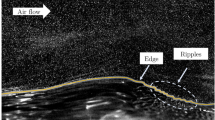Abstract
This paper considers the near-field dispersion of an ensemble of tracer particles released instantaneously from an elevated source into an adiabatic surface layer. By modelling the Lagrangian vertical velocity as a Markov process which obeys the Langevin equation, we show analytically that the mean vertical drift velocity w(t) is w(τ)=bu *(1−e −τ(1+τ)), where Τ is time since release (nondimensionalized with the Lagrangian time scale at the source), b Batchelor's constant, and u *, the friction velocity. Hence, the mean height and mean depth of the ensemble are calculated. Although the derivation is formally valid only when Τ ≪ 1, the predictions for w, mean height and mean depth are consistent in the downstream limit (Τ ≫ 1) with surface-layer Lagrangian similarity theory and with the diffusion equation. By comparing the analytical predictions with numerical, randomflight solutions of the Langevin equation, the analytical predictions are shown to be good approximations at all times, both near-field and far-field.
Similar content being viewed by others
References
Arnold, L.: 1974, ‘Stochastic Differential Equations: Theory and Applications’, Wiley-Interscience, New York, 228 pp.
Batchelor, G. K.: 1964, ‘Diffusion from Sources in a Turbulent Boundary Layer’, Archiv. Mechaniki Stosowanj 3, 661–670.
Chatwin, P. C.: 1968, ‘The Dispersion of a Puff of Passive Contaminant in the Constant-stress Region’, Quart. J. Roy. Meteorol. Soc. 94, 350–360.
Deardorff, J. W.: 1978, ‘Closure of Second- and Third-Moment Rate Equations for Diffusion in Homogeneous Turbulence’, Phys. Fluids 21, 525–530.
Durbin, P. A.: 1980, ‘A Random Flight Model of Inhomogeneous Turbulent Dispersion’, Phys. Fluids 23, 2151–2153.
Durbin, P. A. and Hunt, J. C. R.: 1980, ‘Dispersion from Elevated Sources in Turbulent Boundary Layers’, Journal de Mécanique 19, 679–695.
Hanna, S. R.: 1982, ‘Applications in Air Pollution Modeling’, in F. T. M. Nieuwstadt and H. van Dop (eds.), Atmospheric Turbulence and Air Pollution Modelling, D. Reidel Publ. Co., Dordrecht, Holland.
Hunt, J. C. R. and Weber, A. H.: 1979, ‘A Lagrangian Statistical Analysis of Diffusion from a Ground-Level Source in a Turbulent Boundary Layer’, Quart. J. Roy. Meteorol. Soc. 105, 423–443.
Legg, B. J.: 1983, ‘Turbulent Diffusion from an Elevated Line Source: Markov Chain Simulations of Concentration and Flux Profiles’, Quart. J. Roy. Meteorol. Soc. 109, 645–660.
Legg, B. J. and Raupach, M. R.: 1982, ‘Markov Chain Simulation of Particle Dispersion in Inhomogeneous Flows: The Mean Drift Velocity Induced by a Gradient in Eulerian Velocity Variance’, Boundary-Layer Meteorol. 24, 3–13.
Monin, A. S. and Yaglom, A. M.: 1971, ‘Statistical Fluid Mechanics: Mechanics of Turbulence’, Vol. 1, M.I.T. Press, Cambridge, Mass., U.S.A. (Eng. Trans: J. L. Lumley, ed.).
Raupach, M. R.: 1981, ‘Conditional Statistics of Reynolds Stress in Rough-wall and Smooth-wall Turbulent Boundary Layers’, J. Fluid Mech. 108, 363–382.
Taylor, G. I.: 1921, ‘Diffusion by Continuous Movements’, Proc. Lond. Math. Soc. A20, 196–211.
Author information
Authors and Affiliations
Rights and permissions
About this article
Cite this article
Raupach, M.R. Near-field dispersion from instantaneous sources in the surface layer. Boundary-Layer Meteorol 27, 105–113 (1983). https://doi.org/10.1007/BF00239608
Received:
Issue Date:
DOI: https://doi.org/10.1007/BF00239608




